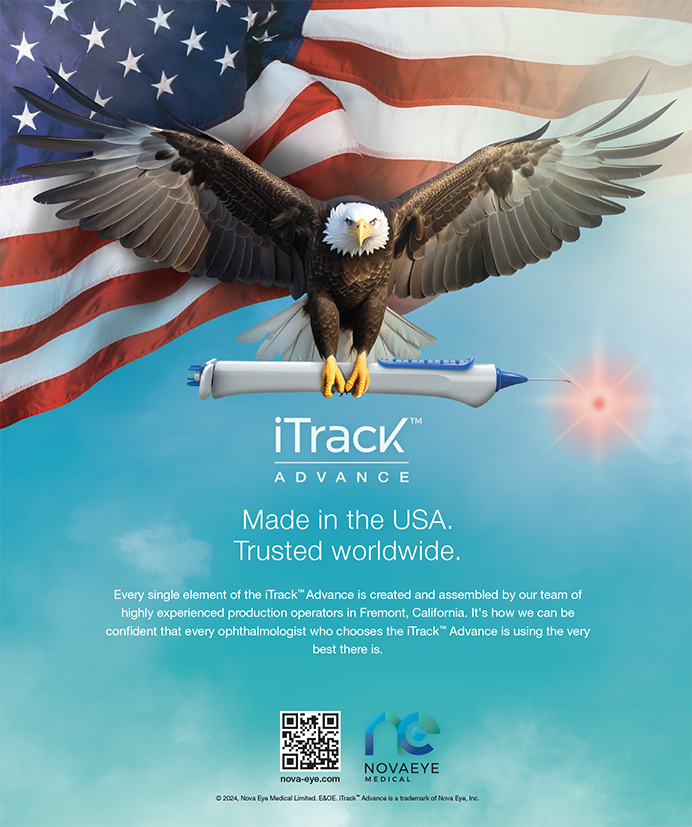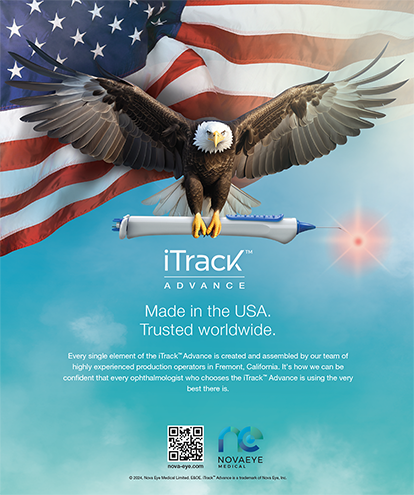Today's cataract patients expect more than clear vision after cataract surgery. They expect refractive results near emmetropia and relative independence from spectacles. The surgeon therefore needs to be skilled at multiple surgical methods for correcting residual ametropia after the cataract procedure. One useful method is to implant a piggyback IOL in the ciliary sulcus over the existing lens implant. This article discusses the indications, contraindications, my surgical technique, and complications involved with this procedure.
INDICATIONS
Patients with a significant postoperative refractive error have three options for its correction. The first is an IOL exchange (see the article by Stephen Lane, MD, on page 25). This procedure is best performed early in the postoperative course before the capsular bag has formed adhesions that essentially lock the IOL into place. For that reason, this option works best when the surgeon feels he or she can safely remove the existing lens implant and still preserve an intact capsular bag. Potential complications include posterior capsular rupture and zonular dialysis that can destabilize the lens implant. A second option is to perform corneal refractive surgery with the excimer laser, which is best accomplished when the refractive error is stable and the cornea and corneal shape are completely normal (see the article by Eric Donnenfeld, MD, on page 32). Laser ablation is not a viable option in patients with abnormal corneal topography or preexisting higherorder aberrations.1 The third option is the implantation of a piggyback IOL, which works best in patients with a hyperopic postoperative refractive error. This form of ametropia is often less predictably corrected by an excimer laser treatment than residual myopia.
In addition to a hyperopic refractive error, the ideal patient for a piggyback IOL has a stable PCIOL that is completely within an intact capsular bag, a normal or deep anterior chamber, a normal corneal endothelium, and no evidence of pigment dispersion syndrome. Patients with a history of RK are also excellent candidates, because they are prone to hyperopic surprises after cataract surgery. Because corrective surgery should be postponed until refractive stability is confirmed, piggyback IOL implantation may be preferable to an IOL exchange in these patients.2
Another advantage of a piggyback IOL is that insurance carriers usually cover the procedure unlike corneal laser refractive surgery. Patients generally experience rapid visual rehabilitation and excellent refractive predictability after a piggyback IOL. Lastly, the lens' insertion into the ciliary sulcus preserves the capsular bag and significantly decreases the chance of vitreous loss compared with an IOL exchange.2
CONTRAINDICATIONS
Not every patient can tolerate a piggyback IOL. Contraindications include the preoperative presence of pigmentary dispersion syndrome, especially in the presence of glaucoma or elevated IOP.3 Patients with loose zonules from trauma or pseudoexfoliation are not good candidates for piggyback IOLs. Neither are those who required a capsular tension ring for primary lens implantation. Posterior synechiae to the capsular bag are another contraindication to the placement of a piggyback lens. Patients with a significantly reduced corneal endothelial cell count are at risk for corneal endothelial cell decompensation with a piggyback lOL, but patients with mild guttata can tolerate these lenses. Piggyback lenses can correct spherical refractive errors but not astigmatism. At this time, toric piggyback lenses are only available outside the United States, so patients with significant degrees of astigmatism—beyond the range of limbal relaxing incisions— may not achieve adequate refractive correction with piggyback lenses alone.
IOL OPTIONS
Piggyback IOLs must be of low power, generally from +4.00 to -4.00 D. The two IOLs most commonly used for this purpose are the Clariflex (Abbott Medical Optics Inc.) and the STAAR AQ5010V (STAAR Surgical Company). Unfortunately, the former is no longer in production. The STAAR IOL is a three-piece silicone IOL with a thin profile and a 6.3-mm optic. It comes in 1.00 D steps from -4.00 to +4.00 D and has a 14-mm interhaptic diameter with a 10º posterior angulation to keep the lens optic away from the posterior surface of the iris.
POWER CALCULATIONS
Piggyback IOLs produce accurate refractive results.4,5 Unlike with an IOL exchange, the lens power calculations rely entirely on the patient's pseudophakic refractive error. The only data necessary for a proper IOL calculation is the A-constant of the piggyback IOL and the postoperative pseudophakic refractive spherical equivalent.5 For patients with postoperative hyperopic refractive errors, the spherical equivalent is multiplied by 1.5 to calculate the proper piggyback IOL power. For myopic refractive errors, the spherical equivalent is multiplied by 1.2 to calculate the necessary myopic piggyback IOL power. IOL power calculations can also be made using the Holladay R formula or the Refractive Vergence Formula first described by Jack Holladay, MD, and popularized by Warren Hill, MD.
TECHNIQUE
The implantation of a piggyback IOL is technically easy. The foldable IOLs can be inserted through a 3-mm incision. I load the piggyback IOL into the injector (Figure 1). I fill the anterior chamber with a dispersive viscoelastic to protect the corneal endothelium. Next, I distend the ciliary sulcus space using a cohesive viscoelastic and then slowly inject the implant into the eye using an IOL injection system (Figure 2). The lead haptic can initially be placed directly into the ciliary sulcus, or the entire lens may be placed in the anterior chamber (Figure 3). I then insert the trailing haptic into the eye and tuck it under the iris using either a Kelman- McPherson forceps or a Lester or Greather hook. If the lens was initially delivered completely into the anterior chamber, I place both haptics under the iris using a hook (Figure 4).
Ideally, there will be a slight separation between the IOL that is fixated in the bag and the piggyback IOL that is fixated in the sulcus (Figure 5). There should also be some space between the anterior aspect of the piggyback IOL and the undersurface of the iris. When the piggyback IOL is in a stable position, I remove all of the viscoelastic from the eye. The corneal incision can either be closed using stromal hydration or a suture. Fortunately, the surgical technique for piggyback IOL implantation is familiar to all cataract surgeons and does not require additional equipment or a learning curve.6,7
COMPLICATIONS
As with any surgical procedure, piggyback IOL implantation can cause complications. They are the same as with any intraocular procedure plus other complications unique to the piggyback IOL. The most common is interlenticular opacification (ILO), which occurs when a membrane grows between the primary lens implant and the piggyback IOL.4 The incidence of this complication can been significantly reduced through the use of an acrylic lens in the bag and a silicone piggyback IOL in the sulcus. Two acrylic lenses or two lens implants within the capsular bag produce a higher incidence of ILO.8
Another complication is postoperative pigment dispersion, which occurs when the piggyback lens rubs against the posterior surface of the iris.3 The use of a lens with a thin profile and a smooth, rounded edge reduces the risk of this problem.9 Other complications include chronic iridocyclitis, glaucoma, hyphema, and corneal decompensation. Lastly, zonular disruption and posterior capsular rupture can occur if the IOL's insertion is traumatic.
NEW DIRECTIONS
A piggyback IOL continues to be a useful and versatile tool for correcting refractive error remaining after cataract surgery, and expanded uses for piggyback IOLs have recently been described, including the correction of refractive error in very young children undergoing cataract surgery. Because a young child's eye continues to grow after cataract surgery, some surgeons are implanting a piggyback IOL at the time of initial cataract extraction to correct the patient's temporary hyperopia. When the eye grows, the piggyback lens can be removed, leaving the primary implant to correct the refractive error in the now fully developed eye.10
Other surgeons have described the use of piggyback IOLs to lessen patients' complaints of negative dysphotopsias after cataract surgery. Masket and Fram have demonstrated that a piggyback lens implant anterior to the anterior capsular edge reduces patients' complaints of negative dysphotopsia.11
New styles of piggyback IOLs are being developed such as the Sulcoflex (Rayner Intraocular Lenses Ltd.; not available in the United States). This single-piece hydrophilic acrylic IOL has an optic diameter of 6.5 mm and an overall diameter of 14 mm. The optic has round, smooth edges, a convex anterior surface, and a concave posterior surface. The haptics are soft and undulating with a 10º posterior angulation designed to keep the IOL away from the posterior surface of the iris. Because these lenses come in three styles—aspheric, multifocal, and toric—they promise to correct both postoperative spherical and astigmatic refractive errors and offer patients the possibility of uncorrected near and distance visual acuity.12
Jonathan B. Rubenstein, MD, is vice chairman and the Deutsch family professor of ophthalmology at Rush University Medical Center in Chicago. He acknowledged no financial interest in the products or companies mentioned herein. Dr. Rubenstein may be reached at (312) 942-2734; jonathan_rubenstein@rush.edu.
- Jin GJ, Merkley KH, Crandall AS, et al. Laser in situ keratomileusis versus lens-based surgery for correcting residual refractive error after cataract surgery. J Cataract Refract Surg. 2008;34(4):562-569.
- Hill WE. Refractive enhancement with piggybacking IOLs. In: Chang DF, ed. Mastering Refractive IOLs: the Art and Science. Thorofare, NJ: Slack Inc.; 2008;792-793.
- Iwase T, Tanaka N. Elevated intraocular pressure in secondary piggyback intraocular lens implantation. J Cataract Refract Surg. 2005;31:1821-1823.
- Gayton JL, Apple DJ, Peng Q, et al. Interlenticular opacification: clinical pathologic correlation of a complication of posterior chamber piggyback intraocular lenses. J Cataract Refract Surg. 2000;26:330-336.
- Gayton JL, Sanders V, Van Der Karr M, et al. Piggybacking intraocular implants to correct pseudophakic refractive error. Ophthalmology. 1999;106:56-59.
- Akaishi L, Tzelikis PF, Gondim J. Primary piggyback implantation using the Tecnis ZM900 multifocal intraocular lens: case series. J Cataract Refract Surg. 2007;33:2067-2071.
- Akaishi L, Tzelikis PF, Gondim J. Primary piggyback implantation using the ReStor intraocular lens: case series. J Cataract Refract Surg. 2007;33:791-795.
- Werner L, Mamalis N, Stevens S, et al. Interlenticular opacification: dual-optic versus piggyback intraocular lenses. J Cataract Refract Surg. 2006;32:655-661.
- Chang WH, Werner L, Fry LL, et al. Pigmentary dispersion syndrome with a secondary piggyback three-piece hydrophobic acrylic lens. J Cataract Refract Surg. 2007;33:1106-1109.
- Boisvert C, Beverly DT, McClatchey SK. Theoretical strategy for choosing piggyback intraocular lens powers in young children. J AAPOS. 2009;13:555-557.
- Masket S, Fram N. Pseudophakic negative dysphotopsia: surgical management and new theory of etiology. J Cataract Refract Surg. 2011;37:1199-1207.
- McIntyre JS, Werner L, Fuller S, et al. Assessment of a single piece hydrophilic acrylic IOL for piggyback sulcus fixation in pseudo-phakic cadaver eyes. J Cataract Refract Surg. 2012;38:155-162.


